http://www.photonics.com/Article.aspx?AID=61292
MANIJEH RAZEGHI, QUANYONG LU, SANTANU MANNA, DONGHAI WU AND STEVEN SLIVKEN, NORTHWESTERN UNIVERSITY
The terahertz (THz) electromagnetic spectrum (1 to 10 THz), sitting between the infrared wavelengths on the higher frequency side and microwaves on the lower frequency side, has unique and important properties. THz waves can pass through a number of materials, including synthetics, textiles, paper and cardboard. Many biomolecules, proteins, explosives or narcotics feature characteristic absorption lines — so-called spectral “fingerprints” — at frequencies between 1 and 10 THz. The two main advantages of THz radiation are the penetration of conventionally opaque materials and high chemical selectivity.
The major applications of THz radiation are imaging, sensing, spectroscopy and communication (Figure 1). Unlike x-rays, THz waves do not have any ionizing effects and are generally considered biologically innocuous. This makes THz waves much safer than x-rays when used for airport security and medical diagnosis.
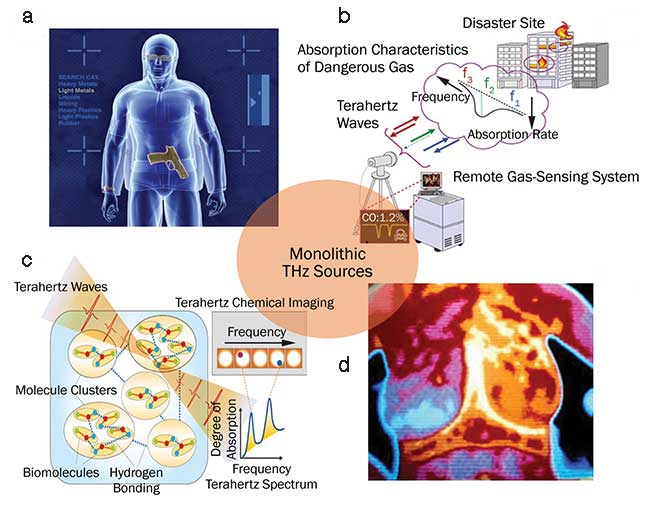
Figure 1. Applications of THz source technology.
Thanks to the rapid development of THz technologies in recent decades, there has been exponential growth in companies, products and research. In fact, BCC Research expects the market to reach $195.3 million by 2018. The diversification of the THz market is expected to accelerate after 2018, and the total market value should exceed $942 million by 20231.
Wanted: high-power, compact THz sources
All of the previously mentioned applications stand to benefit from a compact THz source with high average THz power output. For example, if 100 µW of power images 1 cm2 in five minutes, then 100 mW would image 200 cm2in just one minute, a number that might make it valuable for large-scale security or medical screening. However, the options in high-power compact THz sources are limited. The electronic devices on the lower THz frequency side — frequencies lower than 1 THz — such as Schottky-diode based multipliers, Gunn diodes, resonant-tunneling diodes and impact ionization avalanche transit-time diodes, can deliver a room temperature THz signal with a compact device size2. However, these sources have limited frequency coverage, poor power efficiency and low output power levels at the super THz frequencies, which have a frequency greater than 2 THz. At these higher frequencies, THz quantum cascade lasers (QCLs) have emerged as the most powerful semiconductor THz sources. However, the working temperature is still below 200 K3.
Currently, difference frequency generation (DFG) in mid-IR QCLs, the intracavity nonlinear optical approach, has been able to deliver multi-mW THz power at room temperature4. When a QCL active region is designed with strong nonlinear coupling between the lower lasing levels and injector levels, the result is a large nonlinear susceptibility x(2), and THz emission can be generated within the cavity (Figure 2). When the lower level 2 is designed with a strong coupling with its neighboring level 2′, a large nonlinear susceptibility x(2) up to 104 pm/V will be created in the active region, which is more than two orders of magnitude higher than the nonlinear crystals.
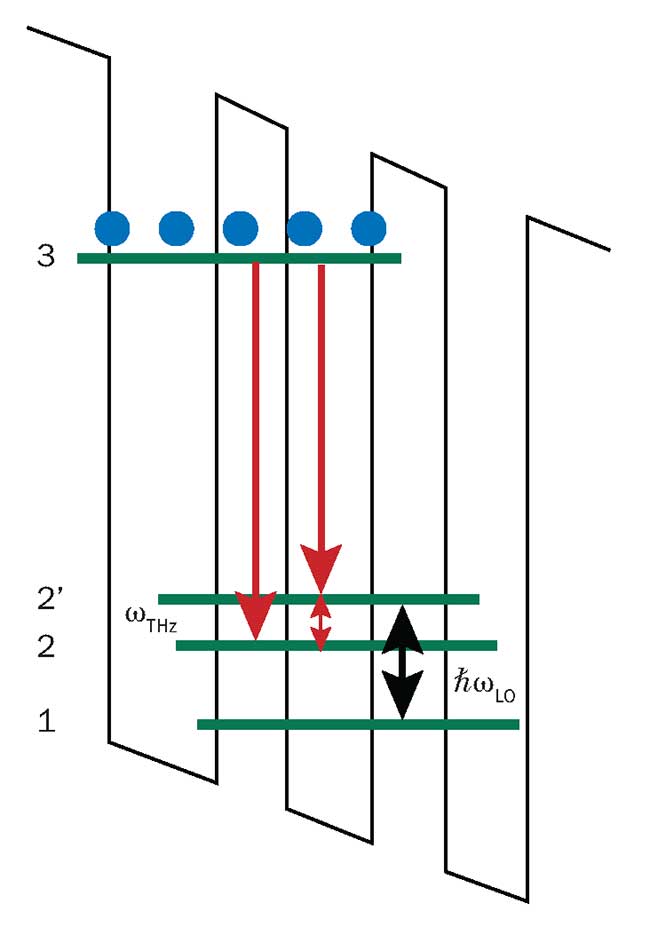
Figure 2. The difference frequency generation (DFG) process between the electron states in a band structure of a quantum cascade laser. Courtesy of Center for Quantam Devices, Northwestern University.
With certain mode-selecting mechanisms, such as the composite distributed feedback grating5, and certain phase- matching mechanisms, such as the modal or the Cerenkov phase-matching scheme with epi-down mounting6, single mode THz emission in a wide spectral range can be generated. Therefore, this type of THz source inherits all of the advantages of the mid-IR QCLs, such as room temperature operation, electrical pumping and compact size, as well as the potential for high-power output and mass production.
High-power QCL sources with wide frequency tuning
The past few years have seen the rapid development of room-temperature THz DFG QCL sources for higher power output, wider frequency tuning and continuous wave operation (Figure 3a). Currently, such devices can emit THz power up to 1.9 mW with a side mode suppression ratio of 30 decibel (dB) at 3.5 THz in pulsed mode operation (Figure 3b)4. In continuous wave operation, they can produce 0.014 mW, with a wide monolithic tuning frequency range of 2.06 to 4.35 THz at room temperature (Figure 4) by using a strain-balanced active region structure and sampled grating design7,8.
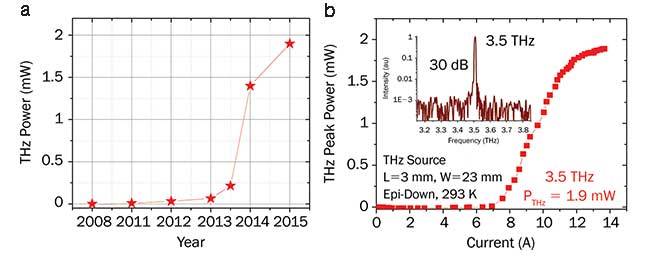
Figure 3. Recently demonstrated THz power records of the THz sources based on DFG quantum cascade lasers (QCLs) at room temperature as a function of year (a). THz power and spectra (inset) for a high power THz source based on DFG QCL (b). Courtesy of Center for Quantam Devices, Northwestern University.
Considering another 30 percent reflection of the THz emissions, the outcoupling efficiency of the emitted THz power with respect to the generated power is as low as 15 percent. Given the maximum recorded 1.9-mW output power, the total generated THz power in the device is estimated to be about 12 mW. Therefore, there is a great potential for THz power enhancement when an efficient THz outcoupler is applied to the THz waveguide. By enlarging the outcoupling aperture with a Si prism to allow for more THz light to be coupled out from the substrate or extracting the THz light from the entire cavity via diffraction grating, even higher THz power and efficiency in a wider spectral range in pulsed and CW modes can be obtained. This is of special importance to high THz frequency generation (>4.5 THz) where the phonon absorption in the semi-insulating InP substrate plays a leading role in the THz absorption prior to outcoupling. Currently, THz QCL sources with a diffraction grating outcoupler can produce THz surface emission with mW level power9.
With further optimization to the diffraction grating design and fabrication, the THz outcoupling efficiency from the diffraction grating, much higher than that from the polished edge facet, has been recently demonstrated. Considering the fact that mid-IR QCLs operating up to 200 W have been demonstrated10, by following a similar strategy, it may be possible to further enhance the THz power to tens of MW by scaling the device.
This revolutionary CW monolithic tunable THz source, which is also compact (packaging size of ~10 × 10 × 2 mm3) and mass-producible, is becoming the ideal light source for emerging THz applications such as spectroscopy and sensing.
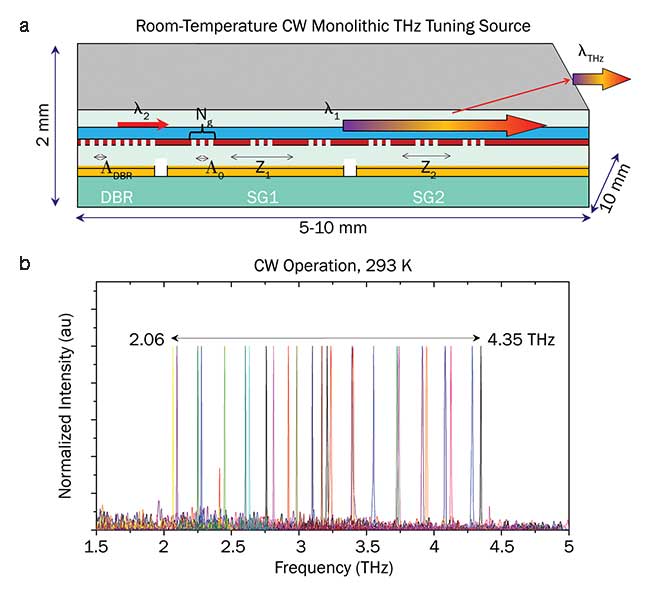
Figure 4. A monolithically tunable THz source based on DFG QCL (a). Tunable THz spectra at room temperature continuous wave operation (b). Courtesy of Center for Quantam Devices, Northwestern University.
High-power QCL frequency comb sources
THz spectroscopy is a vital tool for detecting and quantifying many types of chemical molecules, and plays an important role in environmental monitoring, medical diagnosis, atmospheric chemistry and industrial quality control. Optical frequency combs have revolutionized metrology and spectroscopy with their extraordinary speed and precision. The evenly spaced modes in the frequency domain enable the frequency comb to act as a ruler and provide unprecedented precision and speed compared with other spectrometric techniques. Mode-locked femtosecond lasers have been used for the direct generation of the mid-IR frequency comb; however, the wavelengths are mainly limited to 3 µm11. Deep in the mid-IR and THz wavelength range, QCL frequncy combs are the only monolithic solid-state optical comb sources12,13. As a QCL is engineered with a sufficiently low group velocity dispersion using a broadband heterogeneous active region design, the device can emit a frequency comb via four-wave mixing. Frequency comb operation was achieved from a free-running CW broadband QCL at λ~9.0 µm with a spectral range of 130 cm-1 and an output power of 220 mW for 350 modes (Figure 5a,c). All the lasing modes exhibit near identical frequency spacing of 0.38 cm-1 (11.04 GHz).
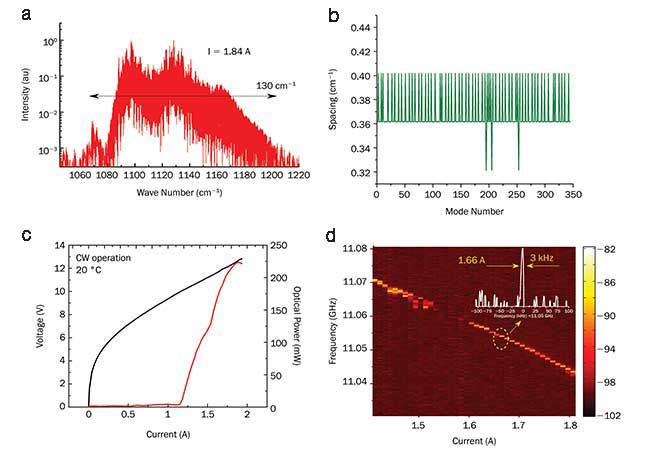
Figure 5. Lasing spectrum measured at a current of 1.84 A (a). The adjacent mode spacing as a function of mode number (b). P-I-V characterization of a 4-mm long Fabry-Perot QCL device in CW operation (c). Intermode beatnote spectra at different current. (Inset) Intermode beatnote spectrum measured at a current of 1.66 A (d). Courtesy of Center for Quantam Devices, Northwestern University.
The intermode beatnote spectra were characterized with a high-speed quantum well infrared detector and the photo-response was measured with a spectrum analyzer. A narrow intermode beating linewidth of 3 kHz (Figure 4d) was observed, which corresponds to a broad spectral coverage of 65 cm-1 and high CW power output of 180 mW for ~176 comb modes, nearly 1 mW power for most of the modes. The frequency comb power was recently enhanced up to 880 mW at λ~8.0 µm with a narrow intermode beatnote linewidth of only 50 Hz.
The demonstrated high-power frequency comb source is likely to find wide applications in chip-based spectroscopy and metrology. It also opens a way to THz optical frequency comb operation at room temperature based on intracavity DFG (down conversion) inside a mid-IR QCL.
Meet the authors
Manijeh Razeghi is the Walter P. Murphy Professor and director of the Center for Quantum Devices (CQD) at Northwestern University in Evanston, Ill.; email: razeghi@eecs.northwestern.edu. Quanyong Lu is a research assistant professor; Santanu Manna and Donghai Wu are postdoctoral researchers; and Steven Slivken is a research associate professor — all at CQD.
References
1. BCC Research (July 2013). Terahertz radiation systems: Technologies and global markets (IAS029C).
2. H. Eisele and G. I. Haddad (1998). Two terminal millimeter-wave sources. IEEE Trans Microwave Theory Tech, Vol. 46, Issue 6, pp. 739–746.
3. S. Fathololoumi and E. Dupont, et al. (2012). Terahertz quantum cascade lasers operating up to ~200 K with optimized oscillator strength and improved injection tunnelling. Opt Express, Vol. 20, p. 3866.
4. M. Razeghi and Q. Y. Lu, et al. (2015). Quantum cascade lasers: from tool to product. Opt Express, Vol. 23, p. 8462.
5. Q. Y. Lu and N. Bandyopadhyay, et al. (2011). Room temperature single-mode terahertz sources based on intracavity difference-frequency generation in quantum cascade lasers. Appl Phys Lett, Vol. 99, 131106.
6. Q. Y. Lu and N. Bandyopadhyay, et al. (2013). Room temperature terahertz quantum cascade laser sources with 215 µW output power through epilayer-down mounting. Appl Phys Lett, Vol. 103, 011101.
7. Q. Y. Lu and N. Bandyopadhyay, et al. (2014). Continuous operation of a monolithic semiconductor terahertz source at room temperature. Appl Phys Lett, Vol. 104, 221105.
8. Q. Y. Lu and D. H. Wu, et al. (2016). Room temperature continuous wave, monolithic tunable THz sources based on highly efficient mid-infrared quantum cascade lasers. Sci Reports, Vol. 6, 23595.
9. M. Razeghi and Q. Y. Lu, et al. (2015). Recent development of high power, widely tunable THz quantum cascade laser sources based on difference-frequency generation. Proc of SPIE, Vol. 9585, 958502-1.
10. D. Heydari and Y. Bai, et al. (2015). High brightness angled cavity quantum cascade lasers. Appl Phys Lett, Vol. 106, 091105.
11. A. Schliesser and N. Picqué, et al. (2002). Mid-infrared frequency combs. Nature Photon, Vol. 6, p. 449.
12. A. Hugi and G. Villares, et al. (2012). Mid-infrared frequency comb based on a quantum cascade laser. Nature, Vol. 492, Issue 229.
13. Q. Y. Lu and M. Razeghi, et al. (2015). High power frequency comb based on mid-infrared quantum cascade laser at λ~ 9 µm. Appl Phys Lett, Vol. 106, 051105.

No comments:
Post a Comment
Please share your thoughts. Leave a comment.